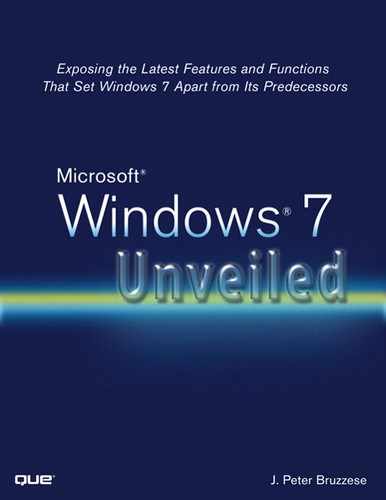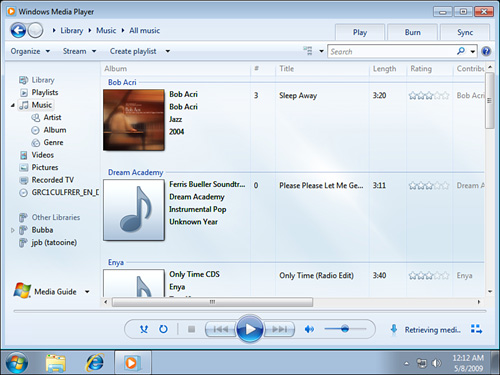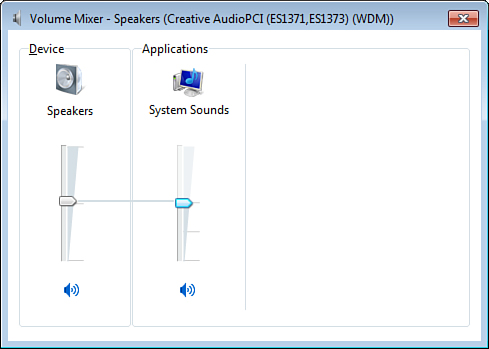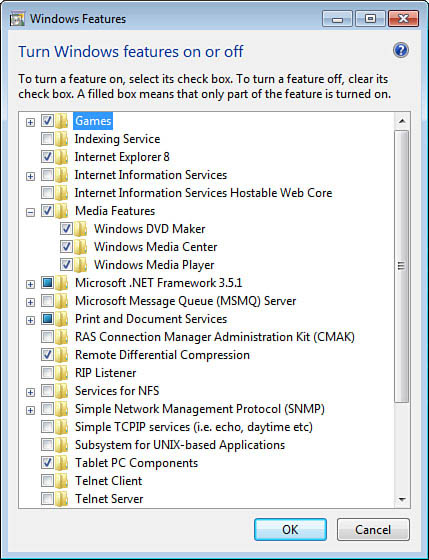IN THIS CHAPTER
Our operating systems are often times our entertainment centers as well. This chapter helps to reveal the new improvements in the Windows Media Player and the Windows Media Center that enhance your viewing experience within Windows 7. We also discuss games, parental controls, and how to turn features on or off within the operating system.
Regardless of what type of media player you use (Microsoft or a third-party player), you will appreciate the changes in Windows Media Player 12 (especially if you are coming from XP’s Media Player 9 or 10). However, even if you are familiar with Media Player 11, you will still see some unique and surprising new features in 12.
For starters, you will quickly note that there are two modes now. There is a separation between the library management side of the player (called Library view) and the “what’s currently playing” mode (called Now Playing view).
The Library view (see Figure 3.1) contains all the organizational elements for your media (such as your playlists and the categorization of your music into Artist, Album, Genre). Here you can set up ratings for music, pictures, or videos. One interesting new aspect of the Library view hierarchy is the ability to view different media types in the tree at the same time.
The Now Playing view (see Figure 3.2) shows the current playlist, visualizations, or videos. There is also a mini-viewer that goes on the taskbar, as well as support for jump lists.
The new Media Player has a streamlined interface that fits in nicely with Windows 7.
Here are some of the features:
• Activity tabs: Activity tabs enable you to quickly select what you need (Play, Burn, Sync).
• Instant search: The search capabilities are once again an important aspect to Windows 7 features. As-you-type searching helps you quickly find your media.
• Network sharing: HomeGroups make sharing your media with others in your group much easier. In addition, Windows Media Player 12 includes support for browsing iTunes media libraries.
• Stacking: Albums that share the same characteristics (Artist, Album, Genre, Year, Rating) are shown in “stacks,” providing you with a visual reference that mimics a stack of CDs or records.
• Preview: From within the Library view, you can hover your cursor over a song or video and select Preview to get a 15-second preview.
• Codec updates: Support is now included for H.264 video, AAC audio, Xvid and DivX video, as well as all the supported codecs from Media Player 11 (including MPEG2, WMV, MP3, and so forth).
• Play to: One of the interesting new features is the ability to “play to” other computers in your HomeGroup. So, you might have music on one system, but you can play it on another system that might have your super-cool sound system.
• Remote streaming to Digital Living Network Alliance v1.5 devices: You may have these networked devices with audio/video playback capabilities and will stream it to them. From within the Library view, you can see an option next to Organize called Stream. From here, you can enable the option Allow Internet Access to Home Media and the option Allow Remote Control of My Player.
Note
In Windows Vista, and now in Windows 7, you may have noticed that video plays smoother than in XP. What accounts for the increased performance? For one thing, the Multimedia Class Scheduler boosts the priority of Media Player threads, and this boost provides glitch-free audio and video. In addition, prioritized I/O and I/O bandwidth reservations keep the I/O pumping. The Multimedia Class Scheduler Service (MMCSS) was a new system service in Windows Vista that runs in a svchost process through the Mmcss.dll used by Media Player. MMCSS enables multimedia applications to ensure that their time-sensitive processing receives prioritized access to CPU resources.
Media Center was an available app for Windows XP Media Center edition (which was only on OEM systems as a preinstalled OS). Vista users had the next version with their Home Premium and Ultimate editions. Windows 7 includes the latest and greatest version of Media Center.
Note
One minor note about Windows 7 flavors and Media Center is that you must at least have Windows 7 Home Premium edition. (The Starter and Home Basic editions will not have the Media Center application or any other media capabilities (such as DVD playback/creation).
Some like to use Media Center in lieu of Media Player on their system because they like the interface. But the true value of Media Center is that of a home-entertainment hub. It enables you to leave the computer in the office, and view your media over the network on multiple TVs using media extenders, or even on your Xbox 360, which has a media extender already built in. You can even purchase an MCE remote control that works with both your TV and your media options.
For the most part, the interface may appear unchanged (which is nice because it makes it easier for us to feel comfortable with this new version). There are many great new features, however, including the following:
• Dissolved shows in background: When you are already watching something and you want to pull up a menu or browse the channel guide, the show you are watching dissolves into the background.
• Thumbnail forward/rewind: If you want to jump around when playing back high-definition video, you can move the time marker and see a thumbnail miniature of the show moving forward/backward at the same time.
• TV launch from Start menu: You can put your Media Center in the Start menu and use a jump list-like hover to go directly to recently recorded shows or other features you use frequently.
• Turbo scroll: A chronological turbo scroll is great, but now there is an alphabetic turbo scroll for media.
• Drifting cover art: This is not necessarily a functional improvement, but when you are listening to a song, the album cover art will appear with metadata included about that track (see Figure 3.3). However, in the background, there will also be cover art from other tracks in your library drifting around. Just a cool effect.
• Scattered photo show: While playing music, you can opt for a photo show of pictures in a folder of your choosing so that pictures are scattered around the screen, and then Media Center will zoom in on them one at a time.
• Copy remote content: Allows you to quickly copy content when browsing other libraries or systems with Media Center.
• Virtual channels without TV tuner: With Internet video channels becoming very popular (for example, YouTube and Hulu), there is less of a need for a TV tuner to watch certain shows.
For those of you who really want to design and build the ultimate Media Center environment, you’ll need all the approved dfMCE (Designed for Media Center Edition) equipment. Here is a link (http://www.microsoft.com/downloads/details.aspx?familyid=30e22722-a2bc-45a4-8f1a-f57503a9312d&displaylang=en) to the Microsoft site where you can download a list of components that are dfMCE-compliant. This includes DVD decoders, graphics cards, TV tuners, remote controls, and wireless routers. The document from Microsoft is called “Designed for Media Center Edition Master List.”
Windows XP didn’t include a DVD-burning solution (with the exception of the Media Center edition), but a CD-burning solution was included. Windows 7 allows for DVD burning directly from several applications, including Explorer and Media Player. You can locate DVD Maker easily by typing in the name at the Instant Search bar.
Note
It’s interesting that the Movie Maker application was pulled out and put into the Live downloads, but the DVD Maker was left in. Some have said that it would have gotten more of an upgrade had it been pulled out. The complaint from Vista users is that it is exactly the same; however, if you have been using XP all this time, you will like what this program can do.
DVD Maker, however, is more than a burning solution that just enables you to put data on a DVD. DVD Maker allows you to create DVD menus and scene selections, in addition to just burning data. The DVD Maker isn’t a fancy tool; it’s nowhere near the level of a third-party DVD-creation tool, but it is functional and simple for new users.
DVD Maker is meant to go up against the Apple iLife application (which includes iDVD), although DVD Maker is not quite at the same high level as iDVD.
The interface is pretty simple, allowing you to add your content (movies and photos), make up a disc title, and then choose your theme. (There are roughly 20 themes, called menu styles, to choose from.) You can change the fonts used, the scene button options, the background music, and so forth.
You don’t have to settle for the available themes. You can take those themes and build off of them by creating custom styles. To do this, click the Customize Menu button, make your changes to the font, the video, and audio settings and the scene button selections, and then choose Save as New Style. Give it a name, and you will now have the Custom Styles option along with the Menu Styles options.
The Windows DVD Maker supports NTSC and PAL TV formats. It also includes options for both the 4:3 output and the 16:9 widescreen resolutions, which you can alter from the Options settings. You can also change the speed for writing to DVD.
Don’t you hate it when you are listening to a great song and you get an IM at the same time and that stupid ding sound? Well, a feature you may have missed in Windows Vista that is still with us, thankfully, in Windows 7 is per-application volume control.
Click the Audio icon in the tray and open the mixer (see Figure 3.4). You will see sound adjustments for several devices. You can use a volume control slider to alter the sound for every running program that produces audio output. When the program is closed, its slider is removed from the mixer options. Even though you might close a program, the volume control will remember what settings you had for that application; therefore, the next time you open the same app, it has the same volume settings (which is great because it means you don’t have to keep configuring sound each time).
Note
Troubleshooting your audio can be done with this tool, too, because you have a green meter that shows the sound for each device. So, if you see a program is producing audio output and the green meter is responding, but you still don’t hear any actual sound, the problem is not with the application. Maybe your speakers are turned down or unplugged.
Obviously, only so much can be done in terms of game enhancements. If you are an XP user, you will find that the games included in Windows 7 are a more modern, hip version of yesteryear’s options. Solitaire has even received a bit of a facelift (which you Vista users have already seen, most likely). There are plenty of game options to choose from, including Internet games that enable you to play against others online.
Note
If you want more games, there is an option under the Games folder for More Games from Microsoft. You can choose from more than a hundred free games to play.
New versions of Windows typically include new versions of DirectX. DirectX is a grouping of application programming interfaces (APIs) that multimedia and game developers can use to tap into the latest and greatest features of an OS to make the most of a game. DirectX is a separate component that can be installed on an OS to bring it up to the latest version, but not always. For example, DirectX 10 required Windows Vista because of a dependency on the new Windows display driver model. So, certain games and multimedia apps requiring DirectX 10 would also require Windows Vista.
DirectX 11 will be able to work on both Vista and Windows 7. Features included in DirectX 11 will be support for GPGPU, tessellation, and improved multithreading support for better multicore utilization in games.
Windows Vista introduced Parental Control options that include a combination of game control, computer-use control, Internet access control, and activity logging. In Windows 7, this has been divided into two pieces. As discussed in Chapter 2, “Application Enhancements,” we can download the Live application called Windows Live Family Safety to configure the Internet and activity log options. However, still included in Windows 7 is the ability to control gaming options.
From within the Control Panel, you can open the Parental Controls applet. Keep in mind that you need to have at least one Standard User account to exercise control options. Select the user, and then you can configure how that user can use the computer (see Figure 3.5). Note that you can still configure Time Limits, Games, and Allow and Block Specific Programs. If it is installed, you can choose additional settings through the Family Safety web filter.
Time limits are relatively easy to configure using a grid system that allows you to determine whether there are any times the user should not be using the computer. If a user is logged on when the time marker hits the “no use” timeframe, the user is automatically logged off.
As for game settings, you can determine whether you want a person to have no ability to play games at all. You can also block (or allow) games by rating, which then enables you to use the Entertainment Software Rating Board (ESRB) to match the user with the rating on the game. You can go a step further and configure additional content-blocking options.
Finally, you can also determine which applications or programs a person can use. Windows will show you a simple interface with check boxes that allow you to choose only those applications allowed.
One of the ways Windows 7 applies the theme of “choice and control,” according to Microsoft, is in allowing you to determine what features you want to have included (or not). Windows 7 includes a comprehensive list that you can use to alter the “features” included with your operating system. Keeping in mind that there are different definitions on what a feature is within an OS, the Windows development team listened to users who requested the ability to pull out pieces, such as the following:
• Windows Media Player
• Windows Media Center
• Windows DVD Maker
• Internet Explorer 8
• Windows Search
• Handwriting Recognition
• Windows Gadget Platform
• Fax and Scan
• XPS Viewer and Services
To turn features on or off, go to the Control Panel, change the view to show Control Panel icons (large or small) and open the Programs and Features applet, and then click the Turn Windows Features On or Off link. Here you will see all the features you have control over, as shown in Figure 3.6, including the media features discussed in this chapter.






